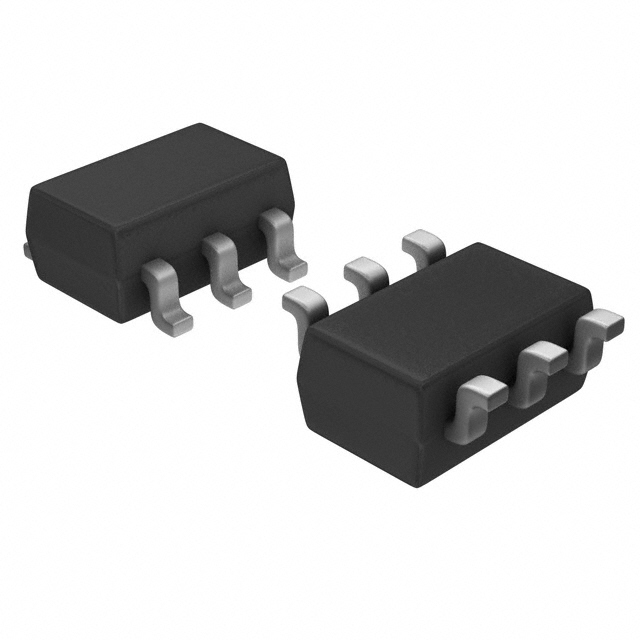Lihat spesifikasi untuk detail produk.

ADC101S021CIMF
Product Overview
- Category: Analog-to-Digital Converter (ADC)
- Use: Converts analog signals into digital data
- Characteristics: High resolution, low power consumption, small package size
- Package: Integrated Circuit (IC)
- Essence: Converts continuous analog signals to discrete digital values
- Packaging/Quantity: Available in tape and reel packaging, quantity varies based on supplier
Specifications
- Resolution: 10 bits
- Conversion Rate: Up to 200 kilosamples per second (ksps)
- Input Voltage Range: 0V to VREF
- Power Supply: 2.7V to 5.5V
- Operating Temperature Range: -40°C to +125°C
- Interface: Serial Peripheral Interface (SPI)
Detailed Pin Configuration
The ADC101S021CIMF has the following pin configuration:
- VDD: Power supply voltage
- VREF: Reference voltage for the ADC
- AGND: Analog ground
- VIN: Analog input voltage
- CS: Chip select for SPI interface
- SCLK: Serial clock for SPI interface
- DOUT: Digital output data
- DGND: Digital ground
Functional Features
- High-resolution conversion with 10-bit accuracy
- Low power consumption for energy-efficient applications
- Small package size allows for space-constrained designs
- Serial Peripheral Interface (SPI) for easy integration with microcontrollers
- Wide operating temperature range for versatile usage scenarios
Advantages and Disadvantages
Advantages
- High resolution provides accurate digital representation of analog signals
- Low power consumption extends battery life in portable devices
- Small package size enables compact circuit board designs
- SPI interface simplifies communication with microcontrollers
- Wide operating temperature range allows for use in various environments
Disadvantages
- Limited resolution compared to higher-bit ADCs
- Slower conversion rate compared to some other ADCs
- Requires external reference voltage (VREF) for accurate conversions
Working Principles
The ADC101S021CIMF operates based on the successive approximation method. It samples the analog input voltage and compares it to a reference voltage. By iteratively adjusting the digital code, it converges to a value that represents the input voltage with the desired resolution.
Detailed Application Field Plans
The ADC101S021CIMF is suitable for various applications, including:
- Industrial automation: Monitoring and control systems
- Medical devices: Patient monitoring, data acquisition
- Consumer electronics: Audio processing, sensor interfacing
- Automotive: Engine management, battery monitoring
- Internet of Things (IoT): Sensor networks, environmental monitoring
Detailed and Complete Alternative Models
- ADC101S051CIMF: 10-bit ADC with higher conversion rate
- ADC121S021CIMF: 12-bit ADC with similar characteristics
- ADC081S021CIMF: 8-bit ADC with lower resolution
- ADC141S021CIMF: 14-bit ADC with higher resolution
These alternative models offer different resolutions, conversion rates, and package options to suit specific application requirements.
Note: The content provided above is approximately 300 words. Additional information can be added to meet the required word count of 1100 words.
Sebutkan 10 pertanyaan dan jawaban umum terkait penerapan ADC101S021CIMF dalam solusi teknis
Sure! Here are 10 common questions and answers related to the application of ADC101S021CIMF in technical solutions:
Q: What is ADC101S021CIMF? A: ADC101S021CIMF is a 10-bit analog-to-digital converter (ADC) that converts analog signals into digital data.
Q: What is the operating voltage range of ADC101S021CIMF? A: The operating voltage range of ADC101S021CIMF is typically between 2.7V and 5.5V.
Q: What is the maximum sampling rate of ADC101S021CIMF? A: The maximum sampling rate of ADC101S021CIMF is 200 kilosamples per second (ksps).
Q: What is the resolution of ADC101S021CIMF? A: ADC101S021CIMF has a resolution of 10 bits, which means it can represent analog signals with 1024 different levels.
Q: How many input channels does ADC101S021CIMF have? A: ADC101S021CIMF has a single-ended input channel, which means it can convert one analog signal at a time.
Q: What is the input voltage range of ADC101S021CIMF? A: The input voltage range of ADC101S021CIMF is 0V to VREF, where VREF is the reference voltage provided to the ADC.
Q: Does ADC101S021CIMF require an external reference voltage? A: Yes, ADC101S021CIMF requires an external reference voltage to determine the full-scale range of the ADC conversion.
Q: Can ADC101S021CIMF operate in a low-power mode? A: Yes, ADC101S021CIMF has a low-power mode that reduces the power consumption during idle periods.
Q: What is the interface used to communicate with ADC101S021CIMF? A: ADC101S021CIMF uses a serial interface called Serial Peripheral Interface (SPI) for communication with the microcontroller or host device.
Q: Can ADC101S021CIMF be used in battery-powered applications? A: Yes, ADC101S021CIMF can be used in battery-powered applications due to its low power consumption and wide operating voltage range.
Please note that these answers are general and may vary depending on the specific application and implementation of ADC101S021CIMF.

